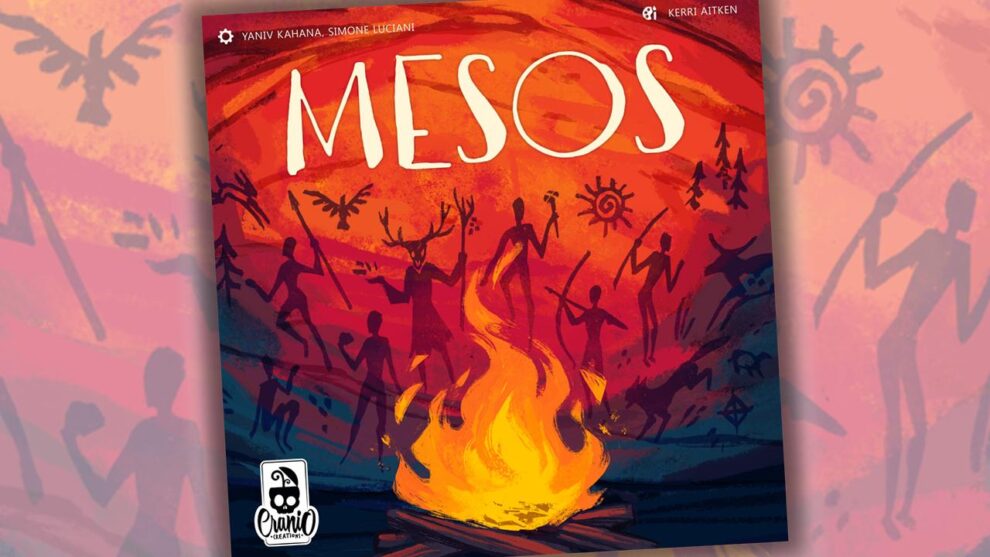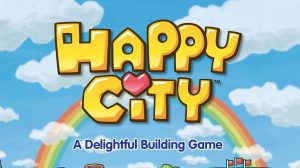Disclosure: Meeple Mountain received a free copy of this product in exchange for an honest, unbiased review. This review is not intended to be an endorsement.
I dumped the components for the new tableau-building game from Cranio Creations, MESOS, onto my table, and one of my review crew members noticed something.
“Man, there are a lot of victory point tokens here,” Wil said. “But do all of them have a negative and positive side? That -20 token doesn’t look good.”
I had to admit that I was scared, too. I had already watched a quick teach video and was prepared to teach the game, but I didn’t know what was going to happen during our play. I was a little worried that scores could dive deep into negative score territory, and then we started the game and found out I was right.
MESOS, designed by Yaniv Kahana (Sea Dragons) and Simone Luciani (yes, that Luciani), with thoughtful artwork featuring tribal communities by Kerri Aitken (Tichu), looks like a pleasant card drafting tableau builder…think something like the weight class of a game like Everdell. Then something happens: every time a player has to decide which position on the drafting track to select, they pause and realize that one wrong move might lead them down a path towards a bucket of negative points.
Family-friendly, MESOS is not. Nor is it for the weak, or anyone who despises getting blown off the table. I’ve seen moments in MESOS where players looked like they might burst into tears, tears of both joy and sadness. (I, myself, have had moments where I both leapt into the air with joy and lowered my head in shame when games of MESOS were over.)
MESOS is one of the big surprises of 2024. It didn’t look like much when I first previewed the game in France earlier this year. But man, MESOS has some teeth!
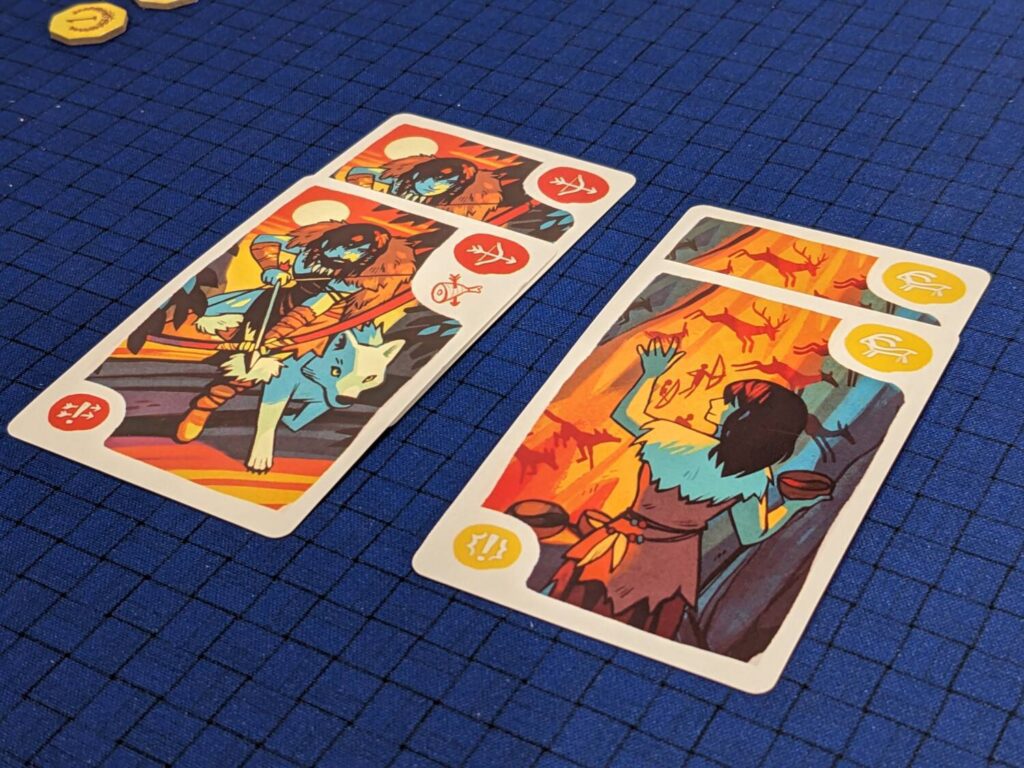
“Hmmm”
MESOS is a 2-5 player card drafting game, with scoring elements tied to both in-game events and end-game set collection requirements. Players must build the best set of tribe members by drafting Characters and building structures by paying food at critical moments during the game. The real key in MESOS is to stay above the fray that is represented by Event cards, which are resolved at certain points during the game.
Each player has a Totem, used to select one of the open spaces on an Offer track. Above and below the Offer track are a certain number of cards based on player count, a mix of Character cards and events spread across three Eras that essentially dial up the intensity level of the events.
A player can select a spot that gets them two, maybe even three, cards from the areas above and/or below the track—but the spots on the track that let a player choose the most cards are always at the end of the track. The earlier spots on the track might let someone only take one card, but that also means they will go earlier in turn order than other players for the next round.
So, you’ve got the tension you would expect in a game like MESOS: line up the order in which cards are drafted, draft the cards, do it again and again. But unlike other tableau builders where everyone scores points based on their sets at the end of play, the events change how things work. That’s because half of the game’s cards only score during the game.
As new cards are added to the markets above and below the Offer track, players have to watch the event cards closely. There are four types of events:
- Sustenance requires players to pay one food for every Character card in their tableau; the Gatherer cards decrease the cost of the Sustenance event.
- The Shamanic Ritual grants the player(s) with the most star icons on Shaman cards a certain number of points—and penalizes the player(s) with the least stars. However, anyone who sits in the middle is not affected.
- The Cave Paintings event grants points for every Artist in a player’s tableau. However as the game goes along, the minimum threshold for Artists grows, requiring players to take Artists and avoid being penalized for having too few of these cards.
- The Hunt is the only event that does not have a negative attached. Players score points and earn food for every Hunter card in their tableau.
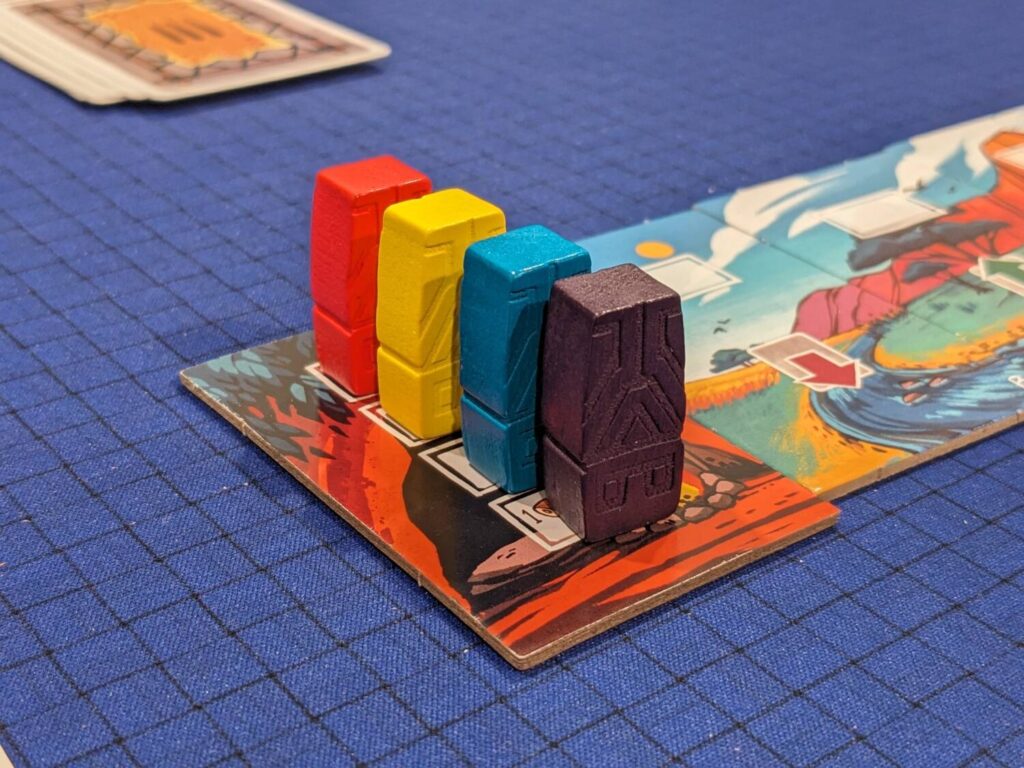
In the first Era of cards, none of these events is particularly harmful. The person who has the fewest number of stars takes a very minor hit if they are behind in Shamans. But by the end of the game, the person with the most stars earns 15 points for the Shamanic Ritual, and the person with the least takes a negative seven-point penalty.
Yes, friends…a 22-point swing. This happened to me in one of my MESOS plays and I’m still bleeding from the eyes.
Events turn MESOS into a game with a lot of “hmmm” moments. By that, I mean that there were many turns where players picked up their Totem, expecting to know where to place it…then thinking their turn through a second, maybe a third, time, hesitating with lots of grunts and groans as they thought through what they should do.
It feels BAD in MESOS to take a single card. Sure, that probably means you are going first in the next round, but with so many cards to draft and so many holes to cover, you almost always want to go last and take more cards. But the turn order track also reveals other pain points—the player that returns their Totem to the first spot in turn order gets a small award of food tokens (vital for the Sustenance event cards) and choosing a card drafting spot on the Offer track first yields incredible benefits.
But going last means you get a good selection of cards…and returning your Totem to the turn order track last means you have to pay a food or suffer a negative two-point hit. Those penalties can really add up, especially in the game’s two-player format, which we’ll come back to.
The tension on these turns have serious consequences. It’s the reason I highly recommend MESOS, but you’ve got to be the right kind of gamer.
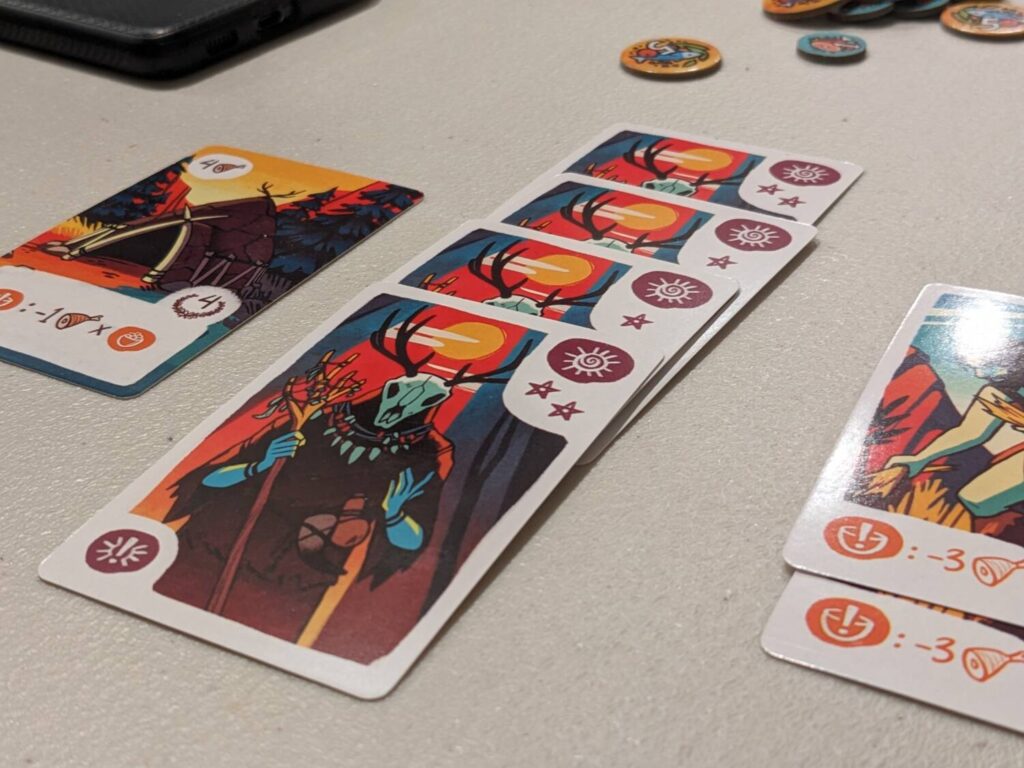
Who is the “Right Kind of Gamer”?
MESOS is fantastic. You can teach it in five minutes, play it in 45 minutes even with a five-player group, and the game will play out a little differently each time because of how the event cards come out. (When a round ends, the cards above the Offer track move down, and the cards that were below the Offer track are discarded. Any events below the Offer track are resolved during this step.)
A small pool of building cards—offering one-time powers or end-game scoring bonuses—help spice up play because players can choose to draft Character cards or pay food tokens to build these structures. The costs of buildings can be further reduced with Builder characters.
I love that three of the six Character card suits are mostly tied to end-game scoring. That means that you have to make hard choices when drafting, say, an Inventor—Inventors do nothing to help defend a player against an event card, but their scoring multiplier might make a difference in the end. Hunters provide the food you need to survive the Sustenance events, but they are worthless at the end of the game (unless a building card rewards that player for Hunter cards).
I think MESOS is going to fit best for a specific type of gamer. One look at those negative VP tokens told me that my kids will never play this game. My wife? She’s out, because she’d rather punch me in the gut than play a game where she might find herself 30 points below the water line halfway through the game. (At one point in one of my plays, I found myself with negative 22 points. Definitely not a warm and fuzzy feeling.)
MESOS is a strategy game in a way that I wasn’t expecting. In plays where I did well, I stuck to the script—draft event-ready cards to stay ahead of the competition, such as Shamans and Gatherers. Once I had enough protection for events, I branched out and secured Artist cards here and Inventor cards late. Building cards that rewarded sets of those event-specific cards (particularly the Building that rewards a player for having a lot of Artists by granting them food during the Cave Painting event) were juicy.
Even though it doesn’t always feel right, I found that a couple times in each game, I had to suck it up and take the very first spot on the Offer track to get the card I wanted and to ensure I went first in the following round.
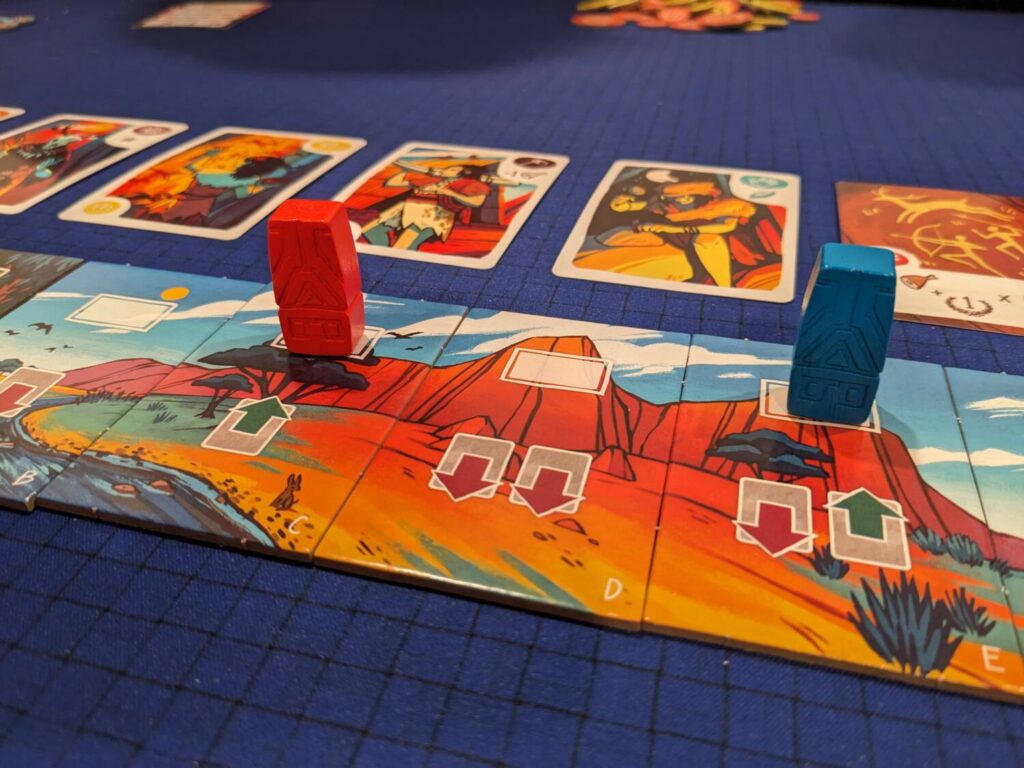
A couple areas didn’t work for me. For this review, I played MESOS at two, four and five players. I loved my plays at four or more players, but my single two-player game did not work for me. That was compounded by two areas—in a two-player game, the player who goes first gets a food, but the player who goes second always has to pay a food or lose two points. I don’t think it feels right that the player who goes second always has to do that.
The second problem I had with the two-player format—when too many events come out at the same time, it can feel like a player doesn’t have the proper time to maneuver themselves into a position to draft the cards they need to be successful. We had a river of event cards (four!) resolve over the course of that game’s initial two turns, which really impacts the ability to rebuild a food engine to buy building cards later.
The tension was still there, but the variety that comes with more players choosing different Offer spots meant that there was a bigger range of chances to select cards in a different order and return to the turn order track without a penalty. The game is so much better at its higher player counts.
The other issue—and this one is minor—is that the game’s final two event cards are always the same, instead of picked randomly from a pool of event cards. One of those is a Shamanic Ritual, so it makes sense that a player should always work to stay in front of the same event in every single game. I wish there was more variety in how this was implemented (maybe distributing events in different ways), because as is, the finale of MESOS is somewhat predictable.
Beyond these areas, MESOS was a winner. Aitken’s artwork is solid and I loved the nuance of featuring both male and female characters in each of the game’s six Character roles. The storage solution here is great…Cranio has a reputation amongst many gamers for coming up short in the realm of production, but MESOS breaks the mold with a cool insert that helps keep all the food and VP tokens manageable, along with a tile storage solution, scoring player aids, and a handy back-of-the-rulebook appendix that answers all questions related to the building card iconography.
If you think you’ll like a stabby, efficient drafting game, MESOS is a very handsome offering. At its higher player counts, MESOS is solid gold.


